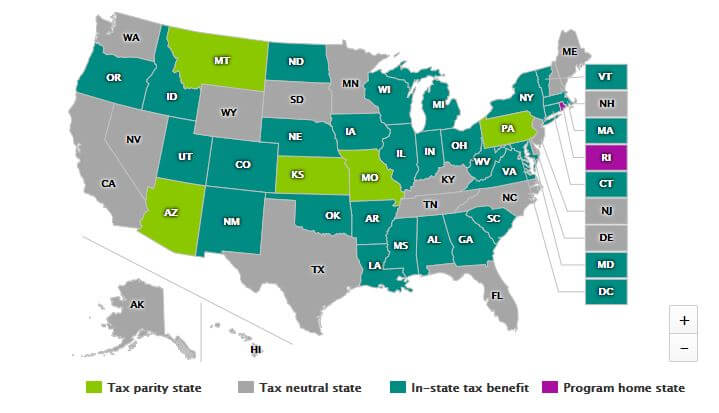Beginning in 2018, the state of Ohio has doubled the available tax deduction for residents contributing to College Advantage 529 plans. The previous deduction was $2,000, and now it will be $4,000 per year and per beneficiary for investments made to their 529 plan. Ohio’s plan is already one of the highest ranked in the nation, but this increase makes Ohio’s 529 plan more competitive.
As an Ohio resident, you should consider if investing in the College Advantage plan is appropriate for you. If you’re saving for college elsewhere, now is an excellent time to compare your choice of plans. If you’re not saving for college yet, it would be a great time to start!
As mentioned in a previous article we posted, there are many ways you can maximize your 529 investment decisions. Check out the map below from Invesco, which gives you a quick glance of each state’s benefit status.

Note…tax parity states allow you to deduct up to a certain amount on your state taxes whether you invest in that state’s plan or another state’s plan.
Should you invest in Ohio or another state?
Should Ohio residents choose their state plan? You can invest in any state’s 529 plan; there are no limitations. To decide if the Ohio state plan is right for you, consider the amount of the tax savings versus the performance of the investment in another state.
As an example, as an Ohio resident, you could be paying approximately 4% on your state income taxes. If you fund two 529 plans, you can take up to a $4,000 deduction per plan or $8,000 total for the year. 4% of $8,000 is a $320 savings on your taxes. Will your investment in another state’s tax plan earn for you $320 more this year?
What if you already started investing in another state’s 529 plan?
If you discover that you can realize tax savings by investing in your home state’s 529 plan but have already opened a plan in another state, you can transfer from one plan to another. It is important to note that 529 rollovers are allowed once per 12-month period per beneficiary NOT per plan. If there are two plans for a single beneficiary, both cannot be rolled over during the same year.
If you invest more than $4,000 you won’t lose the tax deduction.
The $4,000 amount is not a cap on how much you can invest per year. It is the amount of your investment you can deduct on your Ohio income taxes each year. If you contribute more than $4,000, you need to pay attention to Ohio’s income tax carry-forward rules and the Federal annual gift tax rules.
How much can I carry forward for my Ohio income taxes?
As a married couple, if you invest $20,000 in your child’s Ohio 529 this year, you can claim the $4,000 deduction over a period of 5 years — carrying that excess contribution into the future. That is known as “front-loading.”
How does this impact my annual gift tax exclusion?
To avoid any annual gift tax consequences, as of 2018, the yearly maximum amount contributed to any individual beneficiary must be less than $15,000 for a single taxpayer or $30,000 for a married filing jointly couple.
If you contribute more than the $30,000 limit, you can spread out the gift over five years. You can carry forward the surplus over $30,000 into the following year(s) up to a maximum of $150,000 (or $15,000 gift up to $75,000 for a single filer). This will avoid impacting your annual gift tax exclusion, but you will need to file the information with the IRS, so they know what is going on.
While in college, keep investing in your plan
Don’t stop funding your 529 once your child enters college. You should consider running the cash flow through the 529 to receive the tax benefit. Even though the compounding interest benefit is lost for this type of short-term turnaround, the tax deduction is still saving money.
In Conclusion
While the state tax deduction is advantageous for 529 investment, the main reason to invest in a 529 is the tax-deferred growth and tax-free withdrawals for qualified expenses. Although, it certainly is beneficial to understand and apply all aspects of savings when paying for college.

Leave a Reply